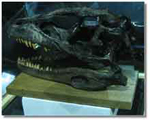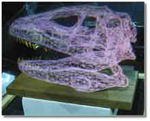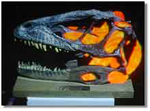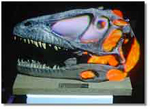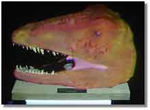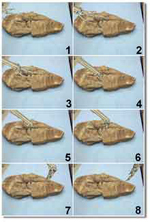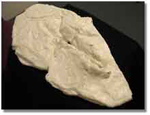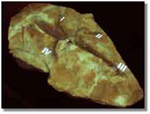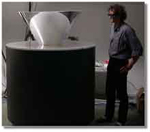 |
||
 | ||
| Congressional Affairs | Newsroom | Speeches | Priority Areas | What's Cool | Publications | Partners | History | About Us | ||
| You are in: NSF Home > OLPA Home > Newsroom > News Tips > October 22, 2002 | ||
|
|||||
|
For more information on these science news and feature story
tips, please contact the public information officer at the end of
each item at (703) 292-8070. Editor:
Josh Chamot Contents of this News Tip: Augmented Reality Brings Dinosaurs into the
21st Century Paleontologists and computer scientists have joined forces
to paint fossils with digital flesh and create dynamic models
that reveal how dinosaurs may have looked, walked and attacked
prey. Called "augmented reality" (AR), researchers have used the
new techniques to fit muscles onto a predator's jawbone and to
interpret a mysterious feature in dinosaur footprints. National Science Foundation (NSF)-supported paleontologists
Stephen Gatesy of Brown University and Lawrence Witmer of Ohio
University collaborated with Oliver Bimber of Bauhaus
University in Germany and colleagues at the Mitsubishi
Electronic Research Laboratory in Cambridge, Massachusetts and
the Fraunhofer Center for Research in Computer Graphics in
Providence, Rhode Island, to develop augmented reality's
paleontology applications. The researchers used augmented reality to determine where
powerful jaw muscles may have attached to the skull of
Deinonychus, a predatory dinosaur. The researchers
hypothesized where muscle, skin, and other parts would fit,
based upon observations of closely-related modern animals, and
stored this information, along with a 3-D scan of the fossil,
in a standard desktop computer. The computer drives the researchers' "Virtual Showcase," a
half-mirrored, conical chamber fitted with numerous projectors
and lighting controls into which fossils are placed. Standing
outside of the showcase and wearing special glasses, the
researchers control the lighting and projected graphics,
creating a 3-D illusion of flesh enveloping original bone. Within the Virtual Showcase, "users perceive real and
virtual content within the same space," said Bimber. "Virtual
and real objects can be anywhere inside the Virtual Showcase,
and multiple users can look at them from different
perspectives, walking around them," he said. A simplified application of the Showcase projects
two-dimensional textures and information onto white casts of
fossils. "Think of the unpainted cast as a kind of screen upon
which the projection is displayed," said Gatesy. Called projection-based illumination, the process is less
expensive than the standard Virtual Showcase and does not
require special glasses or as many graphics components.
However, projection-based graphics can not augment the fossil
in three dimensions. The researchers also used another 2-D, augmented reality
process called live video-mixing to study dinosaur locomotion,
superimposing an animated, skeletal foot onto a footprint cast
from a mudstone in Greenland. The researchers then visualized
the same simulation in 3D within the Virtual Showcase. "By interactively shading the cast inside the Virtual
Showcase, the superimposed animation of the foot can appear in
front of, behind, or within the footprint," said Gatesy.
"Until you've seen the thing in stereo as you move around the
object, it's difficult to describe how effective it is." The AR findings help explain why some dinosaur tracks show
a backwards-pointing first toe - the researchers found that a
forward moving foot can actually create the backward-pointing
slash as it plunges down and forward into mud. In addition to research, the AR technology may also have
applications in museum exhibits, augmenting fossils for a
variety of educational purposes and enhancing details on
display specimens. Just as scientists can easily change data
to meet research needs, museums can change the data guiding a
fossil display. "I'm looking forward to the day when we can create, test,
modify and communicate our hypotheses about soft tissues and
behavior while holding specimens in our hands," said Gatesy.
"Keyboards, mice, and desktop monitors still keep us one step
removed from the raw data, the fossil itself." [Josh
Chamot] For a movie depicting a Deinonychus skull within the
Virtual Showcase, see: The researchers presented the AR system at the October 2002
Society of Vertebrate Paleontology meeting and described the
new technique in the September issue of IEEE Computer Graphics
and Applications - the abstract is available at: Biological Mission to an (Almost) Unknown
Planet The mission of the ALL Species Foundation is to enable the
discovery of all life on Earth in 25 years. Now, the foundation is
participating in a species inventory program - co-developed with
support from NSF and the Alfred P. Sloan Foundation. The Planetary
Biodiversity Inventories (PBI) program, also managed by NSF, is the
first of its kind to invite teams of investigators to conduct a
worldwide, species-level, systematic inventory of an entire, major
group of organisms. "The Planetary Biodiversity Inventories Program is a major step
forward in the exploration of life on Earth; knowledge acquired will
have relevance for all disciplines of biology, for the management of
the environment, and for the promotion of human welfare," said
biologist E. O. Wilson of Harvard University. PBI projects will be large-scale, multi-investigator,
multi-institutional, and multi-national in scope, and they will
provide the first rigorous models for answering global-scale
questions. The inventories will allow researchers to track species
distribution and characteristics across ecological space and through
geological time. [Cheryl Dybas] Study of Endangered Tortoises May Reveal
Impact of Diseases on Ecosystems Building on 10 years of research into an upper respiratory tract
disease that has devastated endangered gopher tortoises across the
United States, scientists are trying to grasp how chronic diseases
spread. The researchers are using wild animal disease as a model for
understanding not just the impact of chronic disease on animals, but
also on entire ecosystems. "The tortoise is unique, as it has about the same life span as a
human, and reaches reproductive age at about the same time," said
Mary Brown of the University of Florida and a lead scientist for the
NSF-funded study. "Lots of changes have occurred in the tortoise's
habitat, many of which are human-induced." The researchers are interested in learning how natural factors
combine with human-induced ones, such as relocation and fire
exclusion, and how those relationships interact with biological and
microbial factors to determine the incidence of disease. In the first year of the new project, the team plans to study
more than 700 tortoises at 30 sites in Florida to determine
population characteristics, habitat quality, and upper respiratory
tract disease status at each location. The sites include state
parks, water management areas, military reserves, and private
holdings. In subsequent years, the researchers will focus on 12 of the
sites using ecological, molecular and other tools to determine the
influence of human-induced factors in disease spread and virulence.
The results should shed light on how disease in its various stages
affects tortoise populations. "Infectious diseases are an ever-present risk to wildlife,
particularly in situations in which animals are removed from their
natural habitat for captive breeding programs, or during conditions
of stress, such as release into new habitats or encroachment into
their habitats by human urbanization," said Brown. "This is even
more important when the species concerned is a keystone species,
such as the Florida gopher tortoise, that is critical to ecosystem
health." As many as 360 animal species depend on the gopher tortoise
for survival, including other threatened species like the indigo
snake. [Cheryl Dybas] |
|||||
|
|
| National Science Foundation Office of Legislative and Public Affairs 4201 Wilson Boulevard Arlington, Virginia 22230, USA Tel: 703-292-8070 FIRS: 800-877-8339 | TDD: 703-292-5090 |
